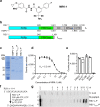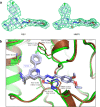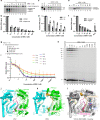Conserved allosteric inhibitory site on the respiratory syncytial virus and human metapneumovirus RNA-dependent RNA polymerases
- PMID: 37337079
- PMCID: PMC10279679
- DOI: 10.1038/s42003-023-04990-0
Conserved allosteric inhibitory site on the respiratory syncytial virus and human metapneumovirus RNA-dependent RNA polymerases
Abstract
Respiratory syncytial virus (RSV) and human metapneumovirus (HMPV) are related RNA viruses responsible for severe respiratory infections and resulting disease in infants, elderly, and immunocompromised adults1-3. Therapeutic small molecule inhibitors that bind to the RSV polymerase and inhibit viral replication are being developed, but their binding sites and molecular mechanisms of action remain largely unknown4. Here we report a conserved allosteric inhibitory site identified on the L polymerase proteins of RSV and HMPV that can be targeted by a dual-specificity, non-nucleoside inhibitor, termed MRK-1. Cryo-EM structures of the inhibitor in complexes with truncated RSV and full-length HMPV polymerase proteins provide a structural understanding of how MRK-1 is active against both viruses. Functional analyses indicate that MRK-1 inhibits conformational changes necessary for the polymerase to engage in RNA synthesis initiation and to transition into an elongation mode. Competition studies reveal that the MRK-1 binding pocket is distinct from that of a capping inhibitor with an overlapping resistance profile, suggesting that the polymerase conformation bound by MRK-1 may be distinct from that involved in mRNA capping. These findings should facilitate optimization of dual RSV and HMPV replication inhibitors and provide insights into the molecular mechanisms underlying their polymerase activities.
© 2023. Merck & Co., Inc., Rahway, NJ, USA and its affiliates.
Conflict of interest statement
D.B., M.E., T.F., K.G., X.H., Y.H., J.H., D.K., B.L., D.M., E.M., T.M., and D.N. are current employees of Merck Sharp & Dohme LLC, a subsidiary of Merck & Co., Inc., Rahway, NJ, USA, and potentially own stock and/or hold stock options in Merck & Co., Inc., Rahway, NJ, USA. Work in the RF lab was sponsored by Merck Sharp & Dohme LLC, a subsidiary of Merck & Co., Inc., Rahway, NJ, USA. At the time of manuscript preparation, the RF lab also has sponsored research agreements with F. Hoffmann-La Roche, Ltd. and Enanta Pharmaceuticals.
Figures




Similar articles
-
Detection of respiratory syncytial virus and human metapneumovirus by reverse transcription polymerase chain reaction in adults with and without respiratory illness.J Clin Virol. 2006 Jan;35(1):46-50. doi: 10.1016/j.jcv.2005.04.004. J Clin Virol. 2006. PMID: 15919236
-
Characterization of the Interaction Domains between the Phosphoprotein and the Nucleoprotein of Human Metapneumovirus.J Virol. 2022 Jan 26;96(2):e0090921. doi: 10.1128/JVI.00909-21. Epub 2021 Nov 3. J Virol. 2022. PMID: 34730389 Free PMC article.
-
Respiratory Syncytial Virus and Human Metapneumovirus Infections in Three-Dimensional Human Airway Tissues Expose an Interesting Dichotomy in Viral Replication, Spread, and Inhibition by Neutralizing Antibodies.J Virol. 2020 Sep 29;94(20):e01068-20. doi: 10.1128/JVI.01068-20. Print 2020 Sep 29. J Virol. 2020. PMID: 32759319 Free PMC article.
-
Structures of the Mononegavirales Polymerases.J Virol. 2020 Oct 27;94(22):e00175-20. doi: 10.1128/JVI.00175-20. Print 2020 Oct 27. J Virol. 2020. PMID: 32847861 Free PMC article. Review.
-
Non-Coding RNAs and Their Role in Respiratory Syncytial Virus (RSV) and Human Metapneumovirus (hMPV) Infections.Viruses. 2020 Mar 21;12(3):345. doi: 10.3390/v12030345. Viruses. 2020. PMID: 32245206 Free PMC article. Review.
Cited by
-
Structure of the Nipah virus polymerase phosphoprotein complex.Nat Commun. 2024 Oct 7;15(1):8673. doi: 10.1038/s41467-024-52701-y. Nat Commun. 2024. PMID: 39375338 Free PMC article.
-
Structure-Activity Relationship of Oxacyclo- and Triazolo-Containing Respiratory Syncytial Virus Polymerase Inhibitors.ACS Med Chem Lett. 2024 Aug 2;15(9):1549-1558. doi: 10.1021/acsmedchemlett.4c00272. eCollection 2024 Sep 12. ACS Med Chem Lett. 2024. PMID: 39291020
-
Small Molecule Drugs Targeting Viral Polymerases.Pharmaceuticals (Basel). 2024 May 20;17(5):661. doi: 10.3390/ph17050661. Pharmaceuticals (Basel). 2024. PMID: 38794231 Free PMC article. Review.
-
Discovery of a non-nucleoside inhibitor that binds to a novel site in the palm domain of the respiratory syncytial virus RNA-dependent RNA polymerase.J Virol. 2025 Jul 22;99(7):e0017825. doi: 10.1128/jvi.00178-25. Epub 2025 Jun 2. J Virol. 2025. PMID: 40454903 Free PMC article.
-
Structural basis for dimerization of a paramyxovirus polymerase complex.Nat Commun. 2024 Apr 11;15(1):3163. doi: 10.1038/s41467-024-47470-7. Nat Commun. 2024. PMID: 38605025 Free PMC article.
References
MeSH terms
Substances
LinkOut - more resources
Full Text Sources

